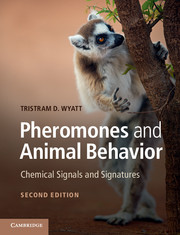Book contents
- Frontmatter
- Dedication
- Contents
- Preface to the second edition
- Acknowledgments
- List of SI prefixes
- List of Abbreviations
- 1 Animals in a chemical world
- 2 Methods for identifying and studying semiochemicals
- 3 Pheromones, chemical cues, and sexual selection
- 4 Coming together and keeping apart: aggregation pheromones and host-marking pheromones
- 5 Territorial behavior and semiochemicals
- 6 Semiochemicals and social organization
- 7 Pheromones and recruitment communication
- 8 Fight or flight: alarm pheromones and cues
- 9 Perception and response to chemical communication: from chemosensory receptors to brains, behavior, and development
- 10 Finding the source: pheromones and orientation behavior
- 11 Breaking the code: illicit signalers and receivers of semiochemicals
- 12 Using semiochemicals: applications of pheromones
- 13 On the scent of human attraction: human pheromones?
- Appendix An introduction to chemical terms for non-chemists
- References
- List of Credits
- Index
10 - Finding the source: pheromones and orientation behavior
Published online by Cambridge University Press: 05 June 2014
- Frontmatter
- Dedication
- Contents
- Preface to the second edition
- Acknowledgments
- List of SI prefixes
- List of Abbreviations
- 1 Animals in a chemical world
- 2 Methods for identifying and studying semiochemicals
- 3 Pheromones, chemical cues, and sexual selection
- 4 Coming together and keeping apart: aggregation pheromones and host-marking pheromones
- 5 Territorial behavior and semiochemicals
- 6 Semiochemicals and social organization
- 7 Pheromones and recruitment communication
- 8 Fight or flight: alarm pheromones and cues
- 9 Perception and response to chemical communication: from chemosensory receptors to brains, behavior, and development
- 10 Finding the source: pheromones and orientation behavior
- 11 Breaking the code: illicit signalers and receivers of semiochemicals
- 12 Using semiochemicals: applications of pheromones
- 13 On the scent of human attraction: human pheromones?
- Appendix An introduction to chemical terms for non-chemists
- References
- List of Credits
- Index
Summary
Finding the source of a pheromone plume in a turbulent flow is a greater challenge than finding an animal producing sound or visual signals. Nonetheless, animals responding to pheromones offer some of the most spectacular examples of remote responses to stimuli. These include male moths attracted to females over hundreds of meters and perhaps even farther. Over evolutionary time, receiving organisms have been selected to search efficiently and to find a source as quickly as possible: many odor sources (whether food or mates) do not last long – the odor source moves or another animal will get there first (Cardé & Willis 2008).
Searching animals exploit the invisible odor “landscape” created by high and low concentrations of countless molecules in overlapping plumes released by other organisms (Atema 2012; Hay 2009; Nevitt 2008). These chemical plumes occur in a wide range of spatial scales and durations. For example, in the sea, they range from the pheromone plume released by a single planktonic copepod, a few millimeters long, to the dimethyl sulfide odor plumes from a plankton “hotspot,” kilometers wide. Odor signals have a significant but limited life before the molecules are dispersed or broken down.
- Type
- Chapter
- Information
- Pheromones and Animal BehaviorChemical Signals and Signatures, pp. 223 - 243Publisher: Cambridge University PressPrint publication year: 2014



